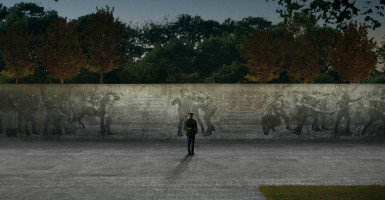World War I is one of the most pivotal events in U.S. history, leaving hundreds of thousands of American soldiers dead in a bloody fight to preserve freedom and democracy.
Today, tourists who descend on the nation’s capital—littered with statues and monuments of remembrance—find not a single national memorial dedicated to all of the Americans who served during the Great War.
“No war in our history needs more visibility or more awareness than World War I because it’s actually one that many people don’t know much about,” Libby O’Connell, chief historian for The History Channel, told The Daily Signal.
“It really marked the beginning of the American century—there were changes in technology, aviation, and the whole spirit of the U.S.”
More than two years after Congress tasked the World War I Centennial Commission to establish a national commemoration site for World War I, the jury on Tuesday unveiled the design of the new memorial.
The congressional commission unanimously chose a design called “The Weight of Sacrifice,” submitted by 25-year-old architect Joe Weishaar of Chicago and veteran sculptor Sabin Howard, 52, of New York, after spending roughly eight months sifting through 350 entries. It was one of five finalists.
O’Connell, who served as a commissioner, said the monument recognizes all who were involved during the war—from the 5 million men and women who signed up to serve on the U.S. home front to support the troops to the nearly 117,000 U.S. servicemen who lost their lives.

“The Weight of Sacrifice” World War I memorial design by architect Joe Weishaar and sculptor Sabin Howard. (Photo: The World War I Centennial Commission)
America entered the war in April 1917, but the war had raged since July 28, 1914. The conflict ended in November 1918.
“World War I represents a war where more men, more of our service people, were lost than [the wars in] Korea and Vietnam combined,” O’Connell said, adding:
All of those things serve to inspire us to take this time to commemorate and honor the effects of World War I, the people who gave their lives, and the effort across the country on a national basis.
The memorial designed by Weishaar and Howard will include transforming Washington’s Pershing Park into an open commemoration nestled on Pennsylvania Avenue, just blocks from the White House and with an open view of the U.S. Capitol. The park already honors Gen. John J. Pershing, who led U.S. forces to victory.
The memorial, expected to cost private donors up to $35 million, will include an elevated lawn surrounded by three walls of remembrance embedded with relief sculptures of servicemen and quotes from generals, soldiers, and politicians woven throughout.
Each cubic foot will reflect one of the 116,516 American soldiers who died. The commission plans to complete the memorial in November 2018 to mark the 100th anniversary of Armistice Day, the official end of the war.
O’Connell lauded the selection for its “clean design” and various entries for access, including a wheelchair ramp.
Ken Clarke, CEO of the Chicago-based Pritzker Military Museum and Library, said a large reason it took so long to dedicate a national monument is that at the time, Americans enlisted in regiments on a local level, so memorials usually were placed in the hometowns of soldiers who died.
“Wars were memorialized in a very different way in World War I,” Clarke told The Daily Signal. “The memorials were done on a very local level—it wasn’t really the style of the day to have a big monument in Washington.”
Because the law bars federal funds from sustaining this project, Clarke said, he and the commission rely on private donations.
His organization pledged $5 million to assist the commission and committed to match another $2.5 million of outside donations.
Although “The Weight of Sacrifice” will mark Washington’s first national memorial commemorating World War I, it is not the first tribute in the nation’s capital to the war’s fallen.
The Second Infantry Division Memorial, dedicated in 1936 by President Franklin D. Roosevelt on Constitution Avenue near 17th Street NW, honors those who were killed while serving in that Army division. It was expanded in 1962 to include two wings memorializing servicemen killed in World War II and the Korean War.
O’Connell said the new monument is important as both a remembrance of the past and a dedication to the future:
Our veterans coming home notice how we think and how we remember wars of the past. They wonder, will we be recognized the way the World War I veterans have been up to now? Which means not much at all in the national consciousness.
O’Connell said Rebecca Wilson, an Iraq War veteran working with the commission, came home from that conflict to see the District of Columbia War Memorial, a locally erected pavilion, overgrown with vines and “forgotten” in a crook of the National Mall.
“She thought, ‘Is this what’s going to happen to me? Is this how my service will be recognized as a place that’s neglected and overlooked?’” O’Connell said.
“Now, she’s one of our key staff to make sure that’s not how we remember World War I, that it’s not just left in a corner and neglected. Because if a vet sees that, how do they know that that’s not going to be how their service is remembered?”
This report has been modified to include the Second Infantry Division Memorial, specify the date war was declared, and correct an editing error regarding Pershing’s title.

























